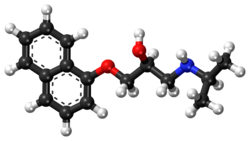普萘洛尔
外观
 | |
 | |
| 临床资料 | |
|---|---|
| 商品名 | Inderal |
| AHFS/Drugs.com | Monograph |
| 核准状况 |
|
| 怀孕分级 |
|
| 给药途径 | 口服、肛门塞剂、直肠、静脉注射 |
| ATC码 | |
| 法律规范状态 | |
| 法律规范 |
|
| 药物动力学数据 | |
| 生物利用度 | 26% |
| 药物代谢 | 肝脏 (extensive) 1A2, 2D6; minor: 2C19, 3A4 |
| 生物半衰期 | 4–5 小时 |
| 排泄途径 | 肾(<1%) |
| 识别信息 | |
| |
| CAS号 | 525-66-6 |
| PubChem CID | |
| IUPHAR/BPS | |
| DrugBank | |
| ChemSpider | |
| UNII | |
| KEGG | |
| ChEBI | |
| ChEMBL | |
| CompTox Dashboard (EPA) | |
| ECHA InfoCard | 100.007.618 |
| 化学信息 | |
| 化学式 | C16H21NO2 |
| 摩尔质量 | 259.35 g·mol−1 |
| 3D模型(JSmol) | |
| 手性 | 外消旋混合物 |
| |
| |
普萘洛尔(Propranolol)属于一种非选择性β受体阻断药[1],常用于治疗高血压、多种心律不整、甲状腺功能亢进症、微血管瘤、表演焦虑症,以及本态性颤抖等[1][2][3]。本品可用于预防偏头痛,以及心绞痛及心肌梗塞发生后的后续心脏问题[1]。本品可经口服或静脉注射给药,口服药剂有分短效型及长效型[1]。服药后30分钟药物会出现于血液中,60至90分钟后则会达到最大药效[1][4]。
常见副作用包含恶心、腹痛,以及便秘等等。心跳过缓及心脏衰竭患者不宜使用。冠状动脉疾病患者过快停药可能会导致症状恶化。本品可能会恶化哮喘的症状,肝肾功能不佳的用药者须多加留意[1]。妊娠期间用药可能会对胎儿造成不良影响[5]。哺乳期间用药应属安全,但仍须注意幼儿是否有副作用产生[6]。
普萘洛尔于1964年发现[7][8]。本品列名于世界卫生组织基本药物标准清单,为基础公卫体系必备药物之一[9]。本品属于通用名药物[1]。2014年,在发展中国家每月剂量的价格在 0.24 至 2.16 美金之间[10]。在美国每月剂量则约为 15 美金[1]。
药理作用
[编辑]药理作用有如下几种。
- 非选择阻抑β受体、高剂量直接抑制心肌、减少心输出量、降低心搏率、减少心脏负荷、用于预防心绞痛
- 降压由于:(1)降低心输出量;(2)影响肾酶(renin)与血管收缩素系统
- 增加胰岛素(insulin)抗药性及减少葡萄糖耐性,会遮盖低血糖引起心悸作用
副作用
[编辑]有恶心、呕吐、腹泻、便秘、忧郁及倦怠感。另外支气管气喘、充血性心衰竭及接受口服降血糖药的糖尿病病人禁用。产生副作用时不可骤然停药,否则易发生心绞痛或心脏再次受损,甚至猝死[11]。
参考文献
[编辑]- ^ 1.0 1.1 1.2 1.3 1.4 1.5 1.6 1.7 Propranolol hydrochloride. Monograph. The American Society of Health-System Pharmacists. [2015-01-01]. (原始内容存档于2020-05-19).
- ^ Davidson, JR. Pharmacotherapy of social anxiety disorder: what does the evidence tell us?. The Journal of Clinical Psychiatry. 2006,. 67 Suppl 12: 20–6. PMID 17092192.
- ^ Chinnadurai, S; Fonnesbeck, C; Snyder, KM; Sathe, NA; Morad, A; Likis, FE; McPheeters, ML. Pharmacologic Interventions for Infantile Hemangioma: A Meta-analysis.. Pediatrics. February 2016, 137 (2): e20153896. PMID 26772662. doi:10.1542/peds.2015-3896.
- ^ Bryson, Peter D. Comprehensive review in toxicology for emergency clinicians 3. Washington, DC: Taylor & Francis. 1997: 167 [2017-01-30]. ISBN 9781560326120. (原始内容存档于2020-12-15).
- ^ Prescribing medicines in pregnancy database. Australian Government. 2014-03-03 [2014-04-22]. (原始内容存档于2014-10-09).
- ^ Gerald G. Briggs, Roger K. Freeman, Sumner J. Yaffe. Drugs in pregnancy and lactation : a reference guide to fetal and neonatal risk 9th. Philadelphia: Wolters Kluwer Health/Lippincott Williams & Wilkins. 2011: 1226 [2017-01-30]. ISBN 9781608317080. (原始内容存档于2017-02-14).
- ^ Russell, RM. The enigma of beta-carotene in carcinogenesis: what can be learned from animal studies.. The Journal of Nutrition. January 2004, 134 (1): 262S-268S. PMID 14704331.
- ^ Ravina, Enrique. The evolution of drug discovery : from traditional medicines to modern drugs 1. Aufl. Weinheim: Wiley-VCH. 2011: 331 [2017-01-30]. ISBN 9783527326693. (原始内容存档于2017-02-14).
- ^ WHO Model List of Essential Medicines (19th List) (PDF). World Health Organization. April 2015 [2016-12-08]. (原始内容存档 (PDF)于2016-12-13).
- ^ Propranolol. International Drug Price Indicator Guide. [January 2016].[永久失效链接]
- ^ Propranolol. [2016-01-01]. (原始内容存档于2021-01-26).
外部链接
[编辑]- Stapleton, M. P. Sir James Black and propranolol. The role of the basic sciences in the history of cardiovascular pharmacology. Texas Heart Institute Journal. 1997, 24 (4): 336–342 [2021-11-10]. ISSN 0730-2347. PMC 325477
 . PMID 9456487. (原始内容存档于2021-11-10).
. PMID 9456487. (原始内容存档于2021-11-10). - U.S. National Library of Medicine: Drug Information Portal - Propranolol (页面存档备份,存于互联网档案馆)
